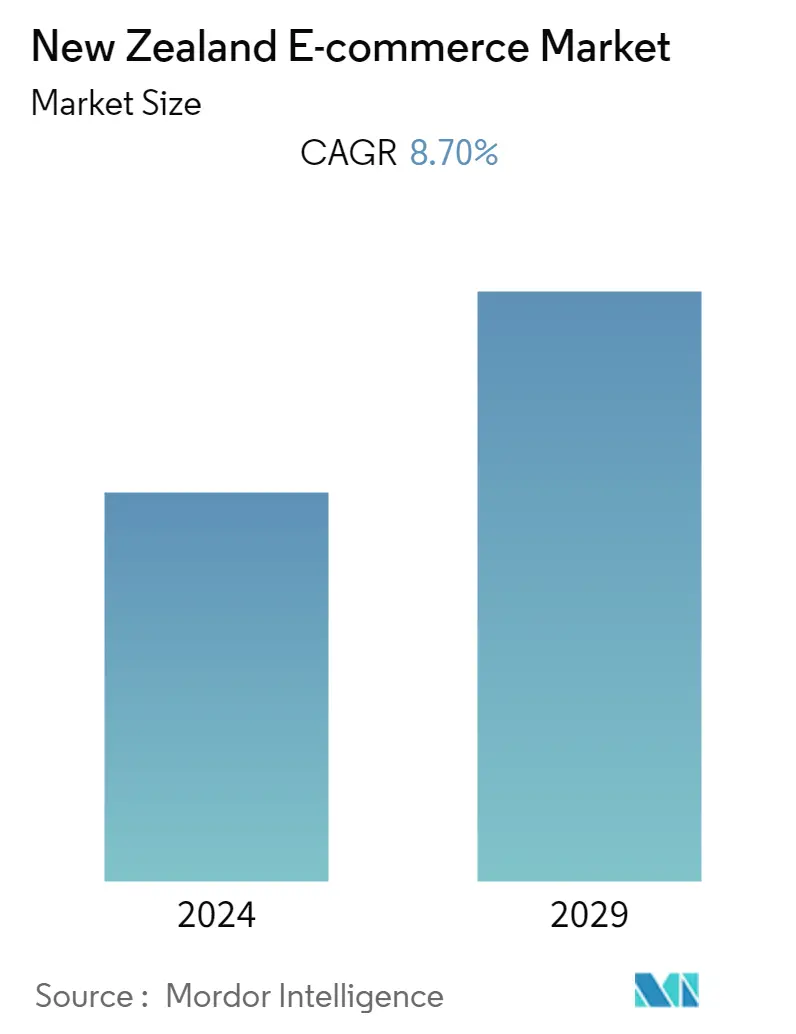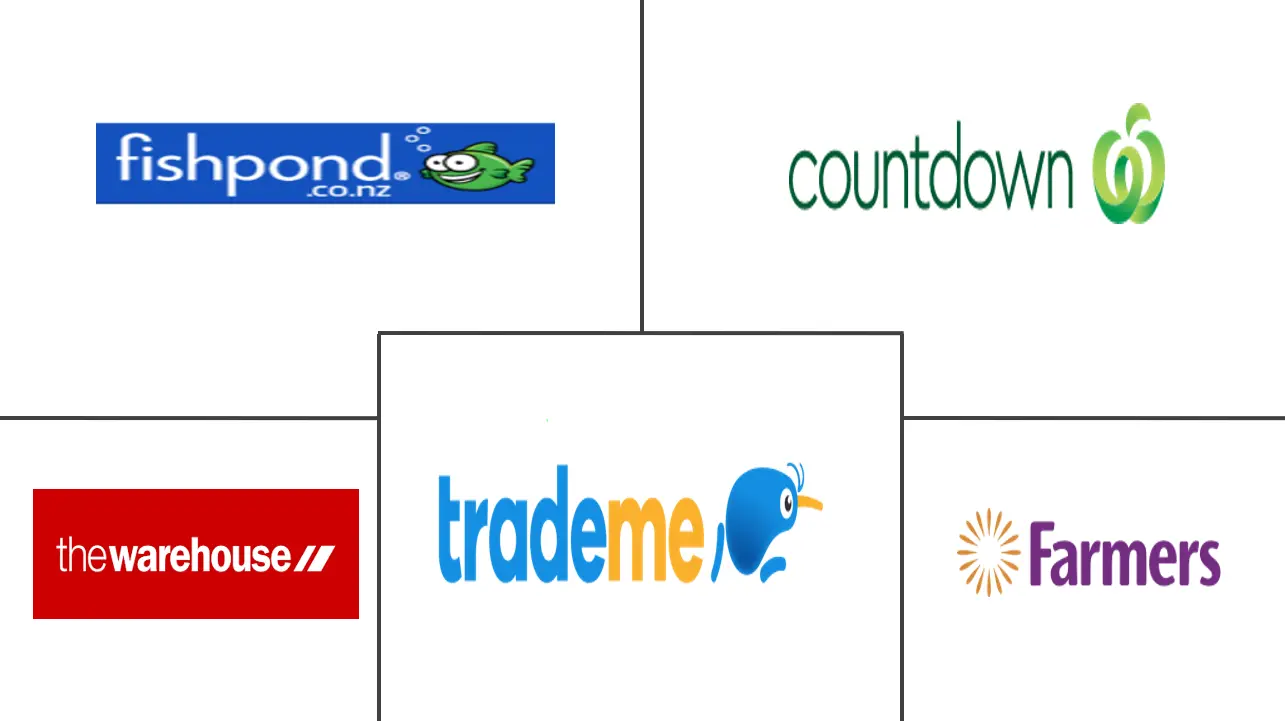Market Size of New Zealand E-commerce Industry

| Study Period | 2019 - 2029 |
| Base Year For Estimation | 2023 |
| Forecast Data Period | 2024 - 2029 |
| Historical Data Period | 2019 - 2022 |
| CAGR | 8.70 % |
| Market Concentration | Low |
Major Players
*Disclaimer: Major Players sorted in no particular order |
New Zealand Ecommerce Market Analysis
The New Zealand e-commerce market is expected to register a CAGR of 8.7% during the period 2022-2027. The primary factor driving the growth of the market in the region is the growing online spending and high smartphone penetration, among others.
- The New Zealand E-commerce market has been transforming rapidly over the past few years. Various factors boost the growth of the E-commerce market in the region, including higher smartphone penetration, increasing shopping frequency, and positive consumer behavior toward online shopping.
- Card payments are the most popular method for E-commerce transactions in the region. However, in the past few years, there have been significant shifts toward Buy Now Pay Later payment methods. As per New Zealand Post, Buy Now Pay Later services in the region grew by 49% in Q1 2021. Furthermore, the service is growing most rapidly among young people in New Zealand.
- As per New Zealand Post, in 2020, older age groups experiencing high levels of online retail growth in terms of their frequency and size of the spend. Then in 2021, the 40-65 years group spent 20% more, and the 65+ age group was also up 14%. Again, these trends will continue throughout the near future. It shows that any assumptions about older shoppers disliking E-commerce are growing increasingly untrue in the region. Further, older shoppers are expected to boost the market over the forecast period.
- Non-resident United States E-commerce companies selling online to New Zealand consumers must comply with local regulations, including consumer and tax procedures. A United States company providing online services to New Zealand residents will need to register for GST when their total supplies of goods and services exceed NZD 60,000 in one year. This type of regulation can resist the foreign E-commerce companies in the region, which may hamper the growth of the market.
- The COVID-19 pandemic national and regional lockdowns have led to New Zealand consumers doubling their spending on online shopping, and the change in consumer spending is further expected to continue to increase in coming years. Fast Moving Consumer Goods (FMCG), including groceries, were the most popular online purchases during the outbreak.
New Zealand Ecommerce Industry Segmentation
E-commerce or electronic commerce is the purchasing and selling of goods or services on the internet. It encompasses various data, systems, and tools for online buyers and sellers, including mobile shopping and online payment encryption. Most businesses with an e-commerce presence use an e-commerce store or an e-commerce platform to conduct online marketing and sales activities.
The New Zealand e-commerce market is segmented into B2C e-commerce and B2B e-commerce. By B2C e-commerce, the market studied is further subdivided into beauty and personal care, consumer electronics, fashion and apparel, food and beverages, furniture and home, and other product types. The study also tracks key market metrics, underlying growth influencers, and significant industry vendors, providing support for market estimates and growth rates in the region throughout the forecasted period. The study goes on to look at COVID-19's overall influence on the ecosystem.
| By B2C E-commerce | ||||||||
| Market Size (GMV) for the Period of 2017-2027 | ||||||||
|
| By B2B E-commerce | |
| Market Size for the Period of 2017-2027 |
New Zealand E-commerce Market Size Summary
The New Zealand e-commerce market is experiencing significant growth, driven by increasing online spending and high smartphone penetration. The market is characterized by a shift in consumer behavior, with more frequent online shopping and a growing acceptance of digital payment methods, such as Buy Now Pay Later services. This trend is particularly evident among younger consumers, although older age groups are also contributing to the market's expansion. The COVID-19 pandemic has further accelerated this growth, with consumers doubling their online shopping expenditures during lockdowns. Fast Moving Consumer Goods, including groceries, have seen a surge in online purchases, reflecting a broader trend towards digital shopping. The market is also witnessing an increase in the number of online shoppers and transaction frequency, which is expected to continue driving growth in the coming years.
The competitive landscape of the New Zealand e-commerce market is fragmented, with several key players like Countdown.co.nz, Trade Me, and FishPond Ltd. actively expanding their offerings and forming strategic partnerships. The fashion sector, in particular, is evolving rapidly, influenced by digital advertising and financial incentives, which are attracting more consumers to online shopping for clothing and footwear. The market is also seeing a rise in digital advertising on social media platforms, which is further boosting demand for fashion products. Recent acquisitions and expansions by companies such as NZ Compare and MyDeal highlight the dynamic nature of the market, as players seek to enhance their presence and cater to a growing customer base. These developments are expected to sustain the market's growth trajectory over the forecast period.
New Zealand E-commerce Market Size - Table of Contents
-
1. MARKET INSIGHTS
-
1.1 Market Overview
-
1.2 Industry Attractiveness - Porter's Five Forces Analysis
-
1.2.1 Bargaining Power of Suppliers
-
1.2.2 Bargaining Power of Buyers/Consumers
-
1.2.3 Threat of New Entrants
-
1.2.4 Threat of Substitute Products
-
1.2.5 Intensity of Competitive Rivalry
-
-
1.3 Key Market Trends and Share of E-commerce of Total Retail Sector
-
1.4 Impact of COVID-19 on the E-commerce Sales
-
-
2. MARKET SEGMENTATION
-
2.1 By B2C E-commerce
-
2.1.1 Market Size (GMV) for the Period of 2017-2027
-
2.1.2 Market Segmentation - by Application
-
2.1.2.1 Beauty and Personal Care
-
2.1.2.2 Consumer Electronics
-
2.1.2.3 Fashion and Apparel
-
2.1.2.4 Food and Beverages
-
2.1.2.5 Furniture and Home
-
2.1.2.6 Others (Toys, DIY, Media, etc.)
-
-
-
2.2 By B2B E-commerce
-
2.2.1 Market Size for the Period of 2017-2027
-
-
New Zealand E-commerce Market Size FAQs
What is the current New Zealand E-commerce Market size?
The New Zealand E-commerce Market is projected to register a CAGR of 8.70% during the forecast period (2024-2029)
Who are the key players in New Zealand E-commerce Market?
Countdown.co.nz, Trade Me, Farmers, The Warehouse NZ and Fishpond Ltd. are the major companies operating in the New Zealand E-commerce Market.

